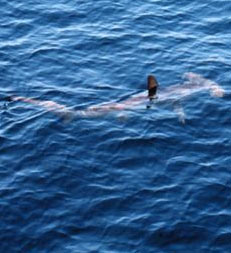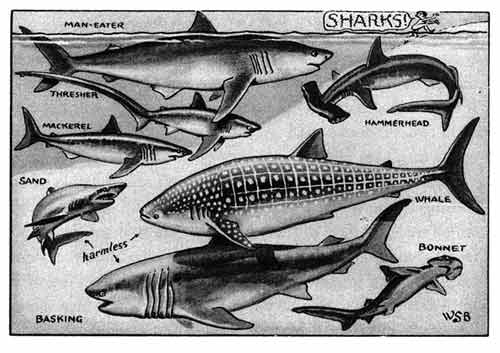|

Why the Hammer? The hammer shape of the head was thought to act as a wing, aiding
in close-quarters maneuverability, allowing sharks to execute sharp
turns without loss of stability. Instead it was found that the vertebra
allowed it to make the turns correctly. It also seems to help in
electrolocation by separating the receptors, thus giving hammerheads
a wider area of search.
Good Sense: These sharks have been able to detect an
electronic signal of half a billionth of a volt. The hammer shaped
head also gives these sharks larger nasal tract,  increasing the
chance of finding a particle in the water by at least 10 times as
compared to other 'classical' sharks. Hammerheads have proportionately
small mouths and seem to do a lot of bottom-hunting. They are also
known to form schools during the day, sometimes in groups of over
100. In the evening, like other sharks, they become lonely hunters. increasing the
chance of finding a particle in the water by at least 10 times as
compared to other 'classical' sharks. Hammerheads have proportionately
small mouths and seem to do a lot of bottom-hunting. They are also
known to form schools during the day, sometimes in groups of over
100. In the evening, like other sharks, they become lonely hunters.
Telling Teeth: Since sharks do not have mineralized bones and rarely fossilize,
it is their teeth alone that are commonly found as fossils. The
hammerheads seem closely related to the carcharhinid sharks that
evolved during the mid-Tertiary Period. Because the teeth of hammerheads
resemble those of some carcharhinids, it has been difficult to determine
when hammerheads first appeared. It is probable that the hammerheads
evolved during the late Eocene, Oligocene or early Miocene.
Of the eight species of hammerhead, three (3) can be dangerous
to humans: the scalloped, great, and smooth hammerheads.

Birds and Bees: Reproduction in the hammerhead shark occurs once a year and each
litter contains 12–15 pups. Hammerhead shark mating courtship
is a very violent affair. The male will bite the female until she
acquiesces, allowing mating to occur. Unlike many other shark species,
the hammerhead shark has internal fertilization which creates a
safe environment for the sperm to unite with the egg. The embryo
develops within the female inside a placenta and is fed through
an umbilical cord, much like in mammals. The gestation period is
10–12 months. Once the pups are born the parents do not stay
with them and they are left to fend for themselves.

All text is available under the terms
of the GNU Free Documentation License
|